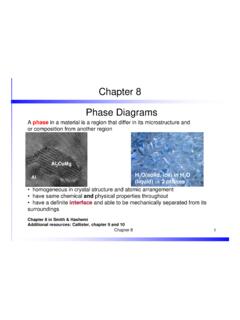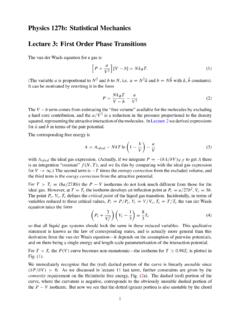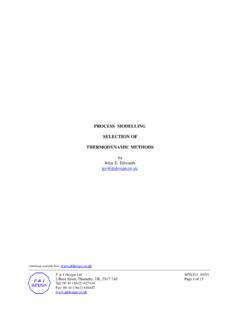Search results with tag "Gibbs phase rule"
Archived Lecture Notes #10 - Phase Equilibria and Phase ...
ocw.mit.eduThe phase rule, also known as the Gibbs phase rule, relates the number of components and the number of degrees of freedom in a system at equilibrium by the formula F = C – P + 2 [1] where F equals the number of degrees of freedom or the number of independent
Thermodynamics and Phase Diagrams
www.crct.polymtl.cathe interpretation and calculation of phase diagrams of all types. In Sec. 3 the Gibbs Phase Rule is developed in a general form suitable for the understanding of phase diagrams involving a wide range of variables including chemical potentials, enthalpy, volume, etc. Sec. 4 begins with a review of the thermodynamics of solutions and
Chapter 8 Phase Diagrams - Western University
physics.uwo.caGibbs' phase rule describes the possible # of degrees of freedom (F) in a closed system at equilibrium, in terms of the number of separate phases (P) and the number of chemical components (C) in the system (derived from thermodynamic principles by Josiah W. Gibbs in the 1870s) Component is the minimum # of species necessary to define the
First Order Phase Transitions
pmaweb.caltech.eduprovides a single constraint on the two variables T;P, i.e. two phase coexistence occurs along a line in the P;Tplane—an example of the Gibbs phase rule. Using this expression at nearby points on the coexistence line and the thermodynamic identity d DdgD−sdTCvdP (9)
PROCESS MODELLING SELECTION OF THERMODYNAMIC …
www.chemicalprocessing.com2.2 Gibbs Phase Rule(2) The variables that define a process condition are in two categories Extensive variables moles, mass, volume Intensive variables temperature, pressure, density, specific volume, mass and mole fractions of components i. The number of intensive variables that can be independently specifiedfor a system at
Gibbs Phase Rule: f = c – p + 2
www.colby.eduGibbs Phase Rule: f = c – p + 2 f = Intensive Degrees of freedom = variance Number of intensive variables that can be changed independently without disturbing the number of phases in equilibrium p = number of phases gas, homogeneous liquid phases, homogeneous solid phases c = components Minimum number of independent constituents Case I.
Gibbs Phase Rule: f = c – p + 2
www.colby.eduColby College Gibbs Phase Rule: f = c – p + 2 f = Intensive Degrees of freedom = variance Number of intensive variables that can be changed independently without





